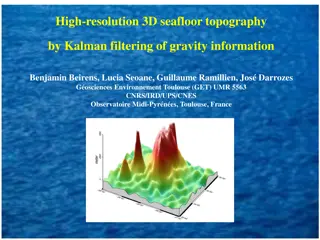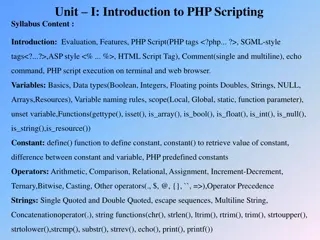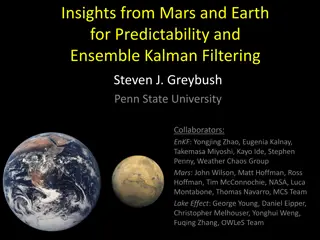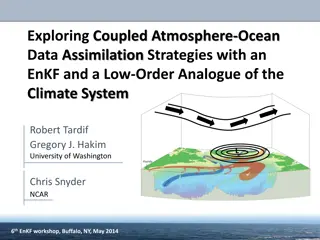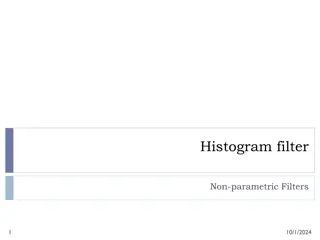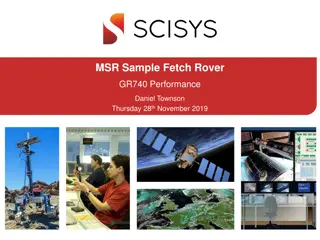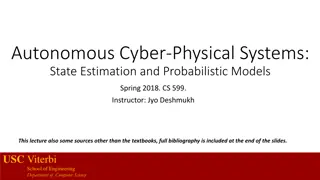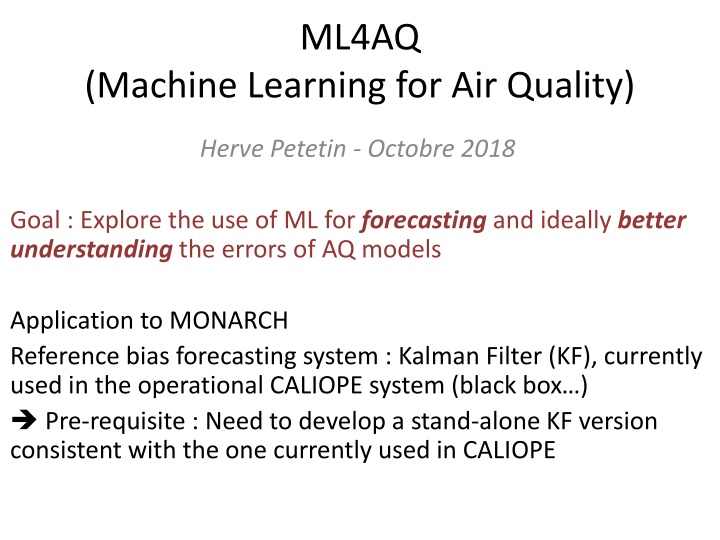
Exploring Machine Learning for Air Quality Forecasting in Kalman Filter System
"Explore the application of Machine Learning in forecasting air quality and understanding errors in models, focusing on developing a stand-alone Kalman Filter consistent with the operational CALIOPE system. The project involves coding a new Kalman Filter version, comparing it with the current system, and optimizing parameter estimation for improved accuracy. Real-time diagnostics illustrate the system's performance in capturing forecast errors on hourly time series data."
Download Presentation

Please find below an Image/Link to download the presentation.
The content on the website is provided AS IS for your information and personal use only. It may not be sold, licensed, or shared on other websites without obtaining consent from the author. If you encounter any issues during the download, it is possible that the publisher has removed the file from their server.
You are allowed to download the files provided on this website for personal or commercial use, subject to the condition that they are used lawfully. All files are the property of their respective owners.
The content on the website is provided AS IS for your information and personal use only. It may not be sold, licensed, or shared on other websites without obtaining consent from the author.
E N D
Presentation Transcript
ML4AQ (Machine Learning for Air Quality) Herve Petetin - Octobre 2018 Goal : Explore the use of ML for forecasting and ideally better understanding the errors of AQ models Application to MONARCH Reference bias forecasting system : Kalman Filter (KF), currently used in the operational CALIOPE system (black box ) Pre-requisite : Need to develop a stand-alone KF version consistent with the one currently used in CALIOPE
What has been done? New stand-alone version of Kalman Filter (hereafter called modkf1) coded in R (detailed notice in progress) Comparison with operational CALIOPE-KF (hereafter called modkf0) time series NB1 : CALIOPE data available only since February 2018 NB2 : Scripts are parallelized on power9, thus easy and fast to analyse large amount of stations
A few words on Kalman filter General formulation of the problem : [ ] Final form of the KF updating equations : The way wt/vt is estimated in the KF is crucial! Many possible approaches exist to estimate this ratio. Here : offline version : test KF on many wt/vt values (e.g. from 0.001 to 100) and selection of the one that minimizes the RMSE or PCC (Pearson correlation coefficient)
A few words on Kalman filter R code : Here, timestep=24 hours NB : Possible to improve even more the filtering with lower timestep (nowcasting)
Estimation of w/v NB : The difference of w/v ratio between the maximum of RMSE and PCC can be substantial but the influence on the final RMSE remains quite low compared to the overall improvement obtained with KF
Illustration of the diagnostics ES1923A(RUR)/O3 Hourly time series :
Illustration of the diagnostics ES1923A(RUR)/O3 Hourly time series : KF filter unable to catch the small-scale variability of the forecast error
Illustration of the diagnostics ES1923A(RUR)/O3 Hourly time series : Expected behavior of the KF : quick convergence (one month) of both the uncertainty and the Kalman gain to a limit value (function of the w/v ratio) When missing data : increase of the uncertainty and KF gain at zero
Illustration of the diagnostics ES1923A(RUR)/O3 Scatter plots (hourly data) : Reasonable agreement between modkf0 and modkf1 Minimum bound at zero not applied in modkf1
Illustration of the diagnostics ES1923A(RUR)/O3 Mean diurnal profiles : Bias entirely removed by KF all along the day Both uncertainty and KF remain roughly constant
Overview at Barcelona stations - O3 Consistent results between modfk0 and modkf1 (both static and dynamic) The reduction of RMSE substantially varies from one station to the other Persistent RMSE of 15-20 ug/m3
Overview at Barcelona stations - O3 Similar conclusions for the PCC (Pearson correlation coefficient) Improvement of the PCC by roughly 0.1
Overview at Barcelona stations - O3 Systematic errors entirely removed at all stations
Overview at Barcelona stations - O3 The (hourly) variability of O3 is underestimated by mod, which is improved with KF
Detection of pollution episodes : Contingency tables mod modkf0 modkf1 (better/unclear/worse with the KF) PM10 in MAD Episode forecasted Non-episode forecasted Episode observed 36 50 - 67 109 67 - 78 Non-episode observed 97 198 - 183 6406 5975 - 6289 NO2 in MAD Episode forecasted Non-episode forecasted Episode observed 0 3 - 2 31 28 - 29 Non-episode observed 3 13 - 11 225227 207606 - 224123 An improvement on RMSE and/or PCC does not necessarily imply an improvement of the performance of the pollution episode alert system
Detection of pollution episodes : Contingency tables mod modkf0 modkf1 (better/unclear/worse with the KF) O3 in MAD Episode forecasted Non-episode forecasted Episode observed 644 692 - 690 550 425 - 504 Non-episode observed 524 374 - 346 5577 5185 - 5720 O3 in BCN Episode forecasted Non-episode forecasted Episode observed 224 141 - 148 122 161 - 198 Non-episode observed 413 145 - 98 4816 4678 - 5103 An improvement on RMSE and/or PCC does not necessarily imply an improvement of the performance of the pollution episode alert system and results may change from one region to other
Conclusion The new version of the KF is consistent with the one used in the operational CALIOPE system it can be used as a reference for evaluating the performance of ML approaches What s next? Kalman filter : Confirm these results over the entire IP domain (544 stations) for all pollutants Investigate more deeply the KF results (e.g. spatio-temporal distribution of the bias and the KF corrections) KF with analogs? Cf. Alicia? Initiate the ML approach : Build a MONARCH dataset with various features (e.g. pollutant concentrations, meteorological values, other) Develop a tool for extracting all usefull MONARCH outputs at the location of the stations? Evaluation tool? Develop first ML approaches and compare results with KF (maybe test a few families of ML algorithms e.g. multilinear regression, tree-based models, neural networks) Possible interactions with Leonardo Bautista Gomez and Albert Njoroge Kahira (Computer Science Department)
Online KF (on-going work...) Dynamic calculation of wt/vt :






